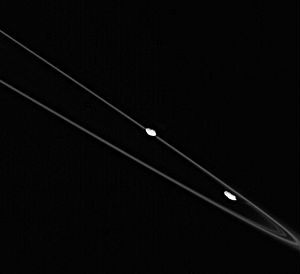Scott Tremaine facts for kids
Quick facts for kids
Scott Tremaine
|
|
|---|---|
| Born |
Scott Duncan Tremaine
1950 Toronto, Ontario
|
| Nationality | Canadian |
| Citizenship | Canada |
| Alma mater | McMaster University Princeton University (PhD) |
| Known for | Theory of galactic dynamics |
| Spouse(s) | Marilyn Tremaine |
| Scientific career | |
| Fields | Astrophysics |
| Institutions |
|
Scott Duncan Tremaine, born in 1950, is a brilliant astrophysicist from Canada. He is a respected member of important science groups like the Royal Society of London and the National Academy of Sciences. Many people consider him one of the best astrophysicists in the world. He is famous for his ideas about how planets and galaxies move. An asteroid, 3806 Tremaine, is even named after him! He also came up with the name "Kuiper belt".
Contents
Scott Tremaine's Journey in Science
Scott Tremaine studied at McMaster University, getting his first degree in 1971. He then earned his PhD from Princeton University in 1975. Later, McMaster University gave him an honorary PhD in 1996.
Early Teaching and Leadership
From 1981 to 1985, he was a professor at the Massachusetts Institute of Technology. In 1986, he became the first director of the Canadian Institute for Theoretical Astrophysics (CITA) at the University of Toronto. He led CITA for ten years until 1996. In 1995, the University of Toronto gave him the special title of "University Professor."
Moving to Princeton and Beyond
In 1997, Scott Tremaine left CITA to become a professor at Princeton University. He was the head of the Astrophysical Sciences department there from 1998 to 2006. In 2007, he moved to the Institute for Advanced Study, where he is currently a professor.
Scott Tremaine is married to Professor Marilyn Mantei Tremaine. She is an expert in how humans and computers interact.
Amazing Discoveries in Space
Scott Tremaine has made many important discoveries about how things move in space.
Predicting Shepherd Moons
In 1979, Tremaine and Peter Goldreich made an amazing prediction. They said that small "shepherd moons" must exist to keep Saturn's thin F ring and Uranus's rings in place. They were right! The moons Prometheus and Pandora were seen near Saturn's F ring in 1981. Shepherd moons were also found around Uranus's rings in 1986.
Understanding Galaxies and Comets
Tremaine also co-wrote a very important book called Galactic Dynamics with James Binney. This book is used by many scientists studying how galaxies move. He also showed that short-period comets come from the Kuiper belt. This is a region of icy objects beyond Neptune.
Solving the Andromeda Galaxy Mystery
Scott Tremaine also helped solve a puzzle about the Andromeda Galaxy. Scientists thought it had two centers. Tremaine suggested that it was actually a single ring of old red stars.
Awards and Special Recognitions
Scott Tremaine has received many awards for his incredible work in astrophysics.
- In 2020, he was chosen as a Legacy Fellow of the American Astronomical Society.
- He won the Tomalla Foundation Prize in 2013 for his work on how gravity affects things in space.
- In 2010, the University of Toronto gave him an honorary doctorate. This was to recognize his contributions to astrophysics and his leadership in science.
- He received the Research Award from the Alexander von Humboldt Foundation in 2005.
- In 2002, he became a member of the National Academy of Sciences.
- He received an honorary Doctor of Science degree from St. Mary's University in 1999.
- In 1998, he won the Dirk Brouwer Award. This was for his many great contributions to understanding how things move in the Solar System and galaxies.
- He was awarded the Dannie Heineman Prize for Astrophysics in 1997. This was for his smart ideas about how planets, rings, comets, and galaxies move.
- In 1996, McMaster University gave him an honorary Doctor of Science award.
- He became a Fellow of the Royal Society of London and the Royal Society of Canada in 1994.
- In 1990, he received the Rutherford Memorial Medal in Physics. This was for his amazing predictions about planetary rings and the objects that control them.
- He also won the C.S. Beals Award from the Canadian Astronomical Society in 1990.
- In 1983, he won the Helen B. Warner Prize for Astronomy. This award recognized his many important ideas about how things move in space.


